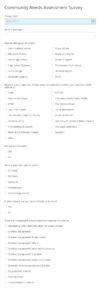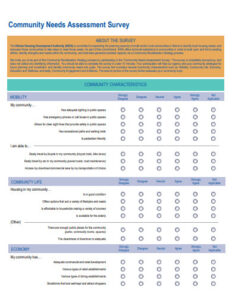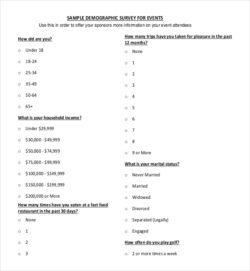Gathering insights from a target audience is fundamental to understanding needs, preferences, or opinions, whether you’re a business owner, a researcher, or a community organizer. While digital tools have revolutionized data collection, there’s a timeless charm and effectiveness in traditional survey methods. Sometimes, the most straightforward approach is indeed the most powerful, reaching individuals who might not be online or prefer a tangible format.
This is where the reliability of a paper and pencil survey template truly shines. It’s an accessible, universally understood method that cuts through digital clutter, allowing for direct, personal engagement. Crafting an effective paper survey doesn’t have to be complicated, especially when you have a well-designed template to guide you, ensuring consistency and clarity in your data collection efforts.
Why Choose a Paper and Pencil Approach for Your Survey?
In an increasingly digital world, it might seem counterintuitive to opt for a paper and pencil survey template. However, this traditional method offers a unique set of advantages that digital alternatives simply cannot replicate. For starters, paper surveys are incredibly accessible. They don’t require internet access, a smartphone, or any particular tech literacy, making them ideal for reaching diverse demographics, including older populations, individuals in remote areas, or communities with limited digital infrastructure. It ensures that everyone has an equal opportunity to participate, providing a truly representative sample.
Furthermore, there’s a certain simplicity and directness that comes with a physical survey. Participants aren’t distracted by pop-ups, notifications, or the glare of a screen. They can take their time, thoughtfully consider each question, and provide detailed responses without feeling rushed or overwhelmed by digital interfaces. This can often lead to higher quality, more reflective data, as respondents feel more engaged and less like they are interacting with a machine.
Cost-effectiveness can also be a significant factor. While there are initial printing costs, these can be minimal compared to subscriptions for advanced online survey platforms, especially for smaller-scale projects or when reaching a localized audience. Distributing paper surveys can be as simple as handing them out in person, placing them in public spaces, or mailing them, requiring fewer technical resources and less complex setup than a digital campaign.
Finally, the physical presence of a paper survey can foster a sense of trust and legitimacy. Handing someone a tangible document can feel more official and personal, encouraging participation. It also avoids common issues like spam filters or technical glitches that can plague online surveys, ensuring your survey actually reaches its intended audience.
Key Advantages of Traditional Surveys
- Wider accessibility across all demographics.
- Reduced digital fatigue and distractions for participants.
- Potential for higher quality, more thoughtful responses.
- Cost-effective for many localized or smaller-scale projects.
- Builds trust and appears more legitimate to some audiences.
- No reliance on internet connectivity or electronic devices.
Crafting an Effective Paper and Pencil Survey Template
Designing a paper and pencil survey template that yields valuable insights requires careful consideration beyond just writing questions. The entire structure and presentation play a crucial role in encouraging participation and ensuring data accuracy. Begin by clearly defining your survey’s objectives. What specific information are you hoping to gather? Knowing your goals will help you formulate precise questions and organize your template logically, making it easy for respondents to follow and for you to analyze later. Think about the flow of information and group related questions together.
The physical layout and visual appeal of your template are surprisingly important. Use clear, legible fonts and ensure there’s ample white space around questions and response options to prevent the survey from looking cluttered and overwhelming. Numbering questions helps respondents and researchers keep track. Consider including brief, clear instructions at the beginning of each section or for specific question types, guiding participants through the process seamlessly. A well-designed, visually appealing template will significantly improve completion rates.
Next, focus on the types of questions you’ll use. A mix of closed-ended questions (e.g., multiple-choice, Likert scales) and open-ended questions can provide both quantitative data for easy analysis and rich qualitative insights. Ensure your questions are clear, unambiguous, and free of jargon. Avoid leading questions that might sway a respondent’s answer. Pilot-testing your survey with a small group before wider distribution can help you catch any confusing wording or problematic questions, allowing you to refine your template for maximum effectiveness.
Finally, think about the logistics of data collection and organization. Will respondents drop off completed surveys, or will you collect them? How will you handle data entry once the paper surveys are complete? Consider adding a unique identifier to each template if you need to track responses without compromising anonymity. Providing space for comments at the end of the survey can offer unexpected insights that you didn’t explicitly ask for, adding another layer of depth to your findings.
Ready to Gather Your Insights?
Embracing the simplicity and directness of a well-crafted paper survey can open up new avenues for data collection, especially when digital solutions fall short. Whether you’re aiming to reach individuals in low-tech environments, prefer a tangible connection with your respondents, or simply appreciate the straightforwardness of traditional methods, the enduring value of this approach is undeniable. It’s about meeting your audience where they are and collecting information in a way that feels natural and accessible to them.
Developing your own paper and pencil survey template is an investment in effective communication and accurate data gathering. By focusing on clear objectives, thoughtful design, and precise questioning, you can create a powerful tool that helps you understand your target audience better than ever before. This timeless method continues to prove its worth, providing reliable insights that can inform decisions and drive progress across various fields.



